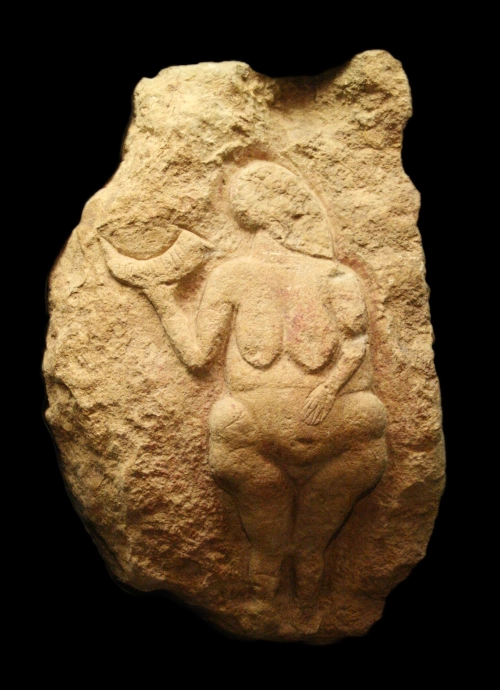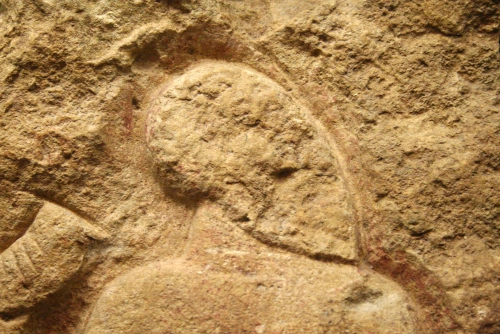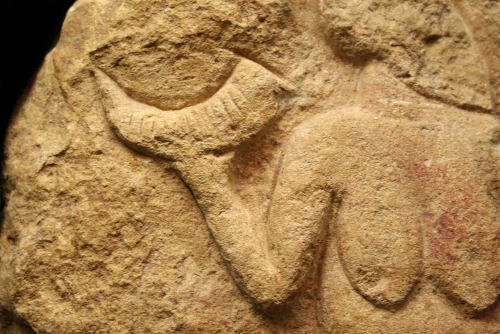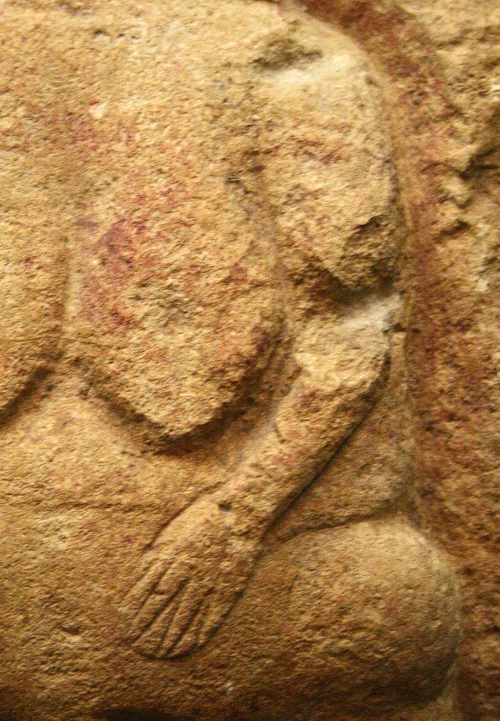The Venus of Laussel is a prehistoric limestone figurine from the Upper Paleolithic period, discovered in 1911 in the Laussel cave in southwestern France. The figurine is about 47 centimeters tall and depicts a female figure holding a bison horn in one hand. And lifting her other hand in a gesture of blessing or protection.
The Venus of Laussel: A Small Limestone Figurine From the Upper Paleolithic Period
The Venus of Laussel is a small limestone figurine that was created during the Upper Paleolithic period, around 25,000 years ago. It was discovered in 1911 in the Laussel cave in southwestern France, and it has since become one of the most significant examples of prehistoric art in the world.
The Discovery of the Venus of Laussel
The Venus of Laussel was discovered in the Laussel cave in southwestern France in 1911. It was found along with other prehistoric artifacts, including stone tools, animal bones, and other figurines.
Laussel cave
The Laussel cave is a remarkable prehistoric site located in southwestern France, which has captured the imaginations of archaeologists, art historians, and enthusiasts around the world. The cave itself is a striking and awe-inspiring natural wonder, featuring deep, winding chambers and dramatic rock formations that have been shaped over thousands of years by the forces of nature.
But it is not just the natural beauty of the Laussel cave that makes it so remarkable. It is also home to a rich and diverse array of prehistoric artifacts, including the iconic Venus of Laussel. These artifacts provide a unique window into the lives, beliefs, and cultural traditions of our prehistoric ancestors, and remind us of the deep and complex history of the human experience.
In addition to the Venus of Laussel, the cave has yielded a wide range of other prehistoric artifacts, including tools, weapons, and artwork. These artifacts provide valuable insights into the lives and practices of our prehistoric ancestors, including their hunting and gathering practices, their social and religious beliefs, and their artistic traditions.
Perhaps most remarkable of all is the fact that these artifacts have survived for thousands of years, providing a tangible link to our prehistoric past and a reminder of the deep and enduring legacy of human culture. Through the study and preservation of these artifacts, we can gain a deeper appreciation for the rich history and diverse cultural traditions of our prehistoric ancestors, and come to better understand our own place in the world today.
Overall, the Laussel cave represents a remarkable and inspiring testament to the enduring power of human creativity, ingenuity, and culture. It is a reminder of the deep and complex history of the human experience, and an inspiration to all those who seek to better understand our past and our place in the world today.
Jean-Gaston Lalanne
Jean-Gaston Lalanne was a French archaeologist who made one of the most significant discoveries in the history of prehistoric art: the Venus of Laussel. Lalanne was born in 1874 in southwestern France, and spent much of his early life exploring the rugged and wild terrain of the Dordogne region.
In 1911, Lalanne was exploring the Laussel cave, which was known to contain a rich and diverse collection of prehistoric artifacts. As he explored the winding chambers of the cave, he stumbled upon a small limestone figurine that would come to be one of the most iconic and well-known prehistoric artifacts in the world: the Venus of Laussel.
Lalanne immediately recognized the significance of his find, and began to study the Venus of Laussel in detail. His meticulous attention to detail and careful observations helped to shed light on the rich and diverse cultural traditions of our prehistoric ancestors, and provided valuable insights into the beliefs, practices, and artistic traditions of the Upper Paleolithic period.
Prior to his discovery of the Venus of Laussel, Lalanne had already established himself as a prominent figure in the field of archaeology. He had published numerous papers and articles on prehistoric art and culture, and was known for his keen eye for identifying and interpreting prehistoric artifacts.
Lalanne’s discovery of the Venus of Laussel was not just a remarkable feat of archaeology, it was also a testament to the power of human curiosity, ingenuity, and creativity. By uncovering this remarkable artifact, Lalanne helped to shed light on the rich and diverse cultural traditions of our prehistoric ancestors, and provided a tangible link to the deep and complex history of the human experience.
Today, the legacy of Jean-Gaston Lalanne lives on in the many artifacts and discoveries that he made during his remarkable career, and in the ongoing work of archaeologists and scholars around the world who continue to uncover the hidden treasures of our prehistoric past. His work serves as a testament to the enduring power of human curiosity and exploration, and a reminder of the deep and complex history of the human experience.
The Size and Material of the Venus of Laussel
The Venus of Laussel stands at about 47 centimeters tall and is made of limestone. The limestone material has helped to preserve the figurine over the centuries, allowing researchers to study it in detail.

Venus of Laussel in Bordeaux museum.
The Distinctive Features of the Venus of Laussel
The Venus of Laussel is depicted holding a bison horn in one hand and lifting her other hand in a gesture of blessing or protection. This unique pose has led many researchers to speculate about the cultural context of the figurine and the beliefs and practices of the people who created it.

Detail of the head.
The Cultural Context of the Venus of Laussel
The Venus of Laussel is believed to have played a role in prehistoric rituals or ceremonies related to fertility, abundance, or the hunt. The bison horn she holds may represent the power and strength of the animal, while the gesture of her other hand could symbolize a plea for its protection or blessings.

Detail of the right arm and the horn.
The Theories About the Meaning and Purpose of the Venus of Laussel
The Venus of Laussel has been interpreted as a representation of a goddess or a shaman, or as a symbol of the connection between human and animal life. The use of a female figure may have been a nod to the power and importance of women in prehistoric society, as well as their connection to the natural world.

Detail of the left arm and hand.
Comparing the Venus of Laussel to Other Prehistoric Figurines
The Venus of Laussel is similar in form and style to other prehistoric figurines found throughout Europe, but its unique features set it apart. Its stylized form and attention to detail are characteristic of the Upper Paleolithic period, and it provides valuable insights into the evolution and development of prehistoric art.
The Technology Used to Study the Venus of Laussel
Researchers have used various imaging techniques to study the Venus of Laussel, including X-ray fluorescence and 3D laser scanning. These techniques have revealed new information about the figurine’s composition and structure, as well as its cultural significance.
One of the most exciting aspects of studying this remarkable artifact is the range of sophisticated and cutting-edge technologies that are now available to help us unlock its secrets and learn more about its origins, history, and cultural significance.
In recent years, researchers have used a range of imaging and scanning techniques to study the Venus of Laussel, including X-ray fluorescence and 3D laser scanning. These techniques allow researchers to create incredibly detailed and accurate three-dimensional models of the Venus of Laussel, which can then be studied in incredible detail using sophisticated software and visualization tools.
One of the key advantages of these techniques is that they allow researchers to study the Venus of Laussel in ways that were previously impossible. For example, X-ray fluorescence can be used to analyze the chemical composition of the limestone used to create the figurine, providing important insights into the geological origins of the stone and the techniques used to shape it.
3D laser scanning, on the other hand, can be used to create an incredibly detailed virtual model of the Venus of Laussel that can be viewed and manipulated from any angle, providing unprecedented insight into the details of its shape, structure, and design.
Taken together, these cutting-edge technologies are helping to shed new light on the Venus of Laussel and the culture and society that created it. They are providing a powerful new set of tools and techniques for studying prehistoric artifacts, and helping to reveal the rich and complex history of the human experience.
The Insights Provided by the Venus of Laussel
The Venus of Laussel provides valuable insights into the beliefs, practices, and artistic traditions of our prehistoric ancestors. It reminds us that the human urge to create and express ourselves through art is as old as our species itself, and that the mysteries of our ancient past still hold many secrets waiting to be uncovered.
The Ongoing Research on the Venus of Laussel
Research on the Venus of Laussel continues to this day, and there is still much to learn about its cultural significance and the people who created it. As new imaging techniques and other technologies are developed, it is likely that we will gain a deeper understanding of the figurine’s meaning and purpose, and the role it played in prehistoric society.
Where is the Venus of Laussel now?
he Venus of Laussel, one of the most famous prehistoric artifacts in the world, is currently housed at the Bordeaux Museum of Aquitaine in southwestern France. The museum is home to a wide range of prehistoric artifacts, including tools, weapons, and art, from the Paleolithic era to the Middle Ages.
The Venus of Laussel is carefully preserved and displayed in a special exhibition space that allows visitors to get up close and personal with this remarkable artifact. The museum also features a range of interactive exhibits and displays that help to bring the history and culture of prehistoric France to life.
While the Venus of Laussel is certainly one of the museum’s most famous and celebrated artifacts, it is just one of many remarkable discoveries that have been made in this region over the years. The museum’s collection includes a wide range of artifacts from the Paleolithic era, including cave paintings, sculptures, and tools, that help to paint a vivid picture of the rich and diverse cultural traditions of our prehistoric ancestors.
Whether you’re a scholar, a history buff, or just a curious traveler, a visit to the Bordeaux Museum of Aquitaine is a truly remarkable experience. The Venus of Laussel and the many other prehistoric artifacts on display there are a testament to the enduring power of human creativity, ingenuity, and curiosity, and a reminder of the deep and complex history of the human experience.
What is the history and context of the Laussel Cave and the other artifacts found within it?
The Laussel Cave is located in southwestern France and is a significant archaeological site, known for its rich collection of prehistoric artifacts. The cave was first discovered in 1911, and since then, it has been the subject of extensive study and research by archaeologists, anthropologists, and other experts in the field.
The Laussel Cave is believed to have been inhabited by prehistoric humans for thousands of years, with evidence of human activity dating back to the Upper Paleolithic period, around 25,000 years ago. The cave contains a variety of artifacts and tools, including stone tools, animal bones, and other figurines, in addition to the Venus of Laussel.
The context in which the Venus of Laussel was found provides valuable insights into the beliefs and practices of the people who created it. The other artifacts found within the cave suggest that the cave may have served as a site for prehistoric rituals or ceremonies related to fertility, abundance, or the hunt. The presence of animal bones and other figurines indicates that the people who lived in the cave had a close relationship with the natural world and a deep understanding of its rhythms and cycles.
In addition to the Venus of Laussel, other notable artifacts found within the Laussel Cave include a variety of animal bones, which have been used to reconstruct the prehistoric environment and diet of the people who lived there. The cave also contains a number of other figurines, which are similar in form and style to the Venus of Laussel, suggesting that the cave was an important center for prehistoric art and culture.
The history and context of the Laussel Cave and the other artifacts found within it provide a fascinating glimpse into the lives of our prehistoric ancestors. They remind us that the human urge to create and express ourselves through art is as old as our species itself, and that the mysteries of our ancient past still hold many secrets waiting to be uncovered.
How was the Venus of Laussel created, and what techniques were used to shape the limestone into its final form?
The process by which the Venus of Laussel was created is one of the great mysteries of prehistoric art. The figurine was crafted from a block of limestone, a relatively soft and easily workable material, using primitive tools such as stone hammers, chisels, and scrapers.
It is believed that the sculptor of the Venus of Laussel would have first chosen a suitable block of limestone and then carefully chipped away at the stone to create the basic shape of the figurine. Once the rough shape was established, the sculptor would have used finer tools to add more detail and texture to the surface of the stone.
It is likely that the sculptor would have worked with the limestone in stages, gradually refining and shaping the figurine until it was just right. This would have required great skill and patience, as well as a deep understanding of the properties of the material and the techniques needed to shape it.
In order to create the distinctive features of the Venus of Laussel, such as the bison horn and the gesture of blessing or protection, the sculptor would have used even finer tools to carve and shape the stone in intricate detail. The final result is a remarkable work of art that is both beautiful and enigmatic, a testament to the skill and creativity of our prehistoric ancestors.
Despite the many advances in modern technology, the techniques used to create the Venus of Laussel remain a mystery. However, through careful study and analysis of the figurine, experts have gained valuable insights into the creative process and artistic traditions of our prehistoric ancestors.
What is the significance of the bison horn held by the Venus of Laussel, and how does it relate to other prehistoric artifacts depicting bison or other animals?
The bison horn held by the Venus of Laussel is one of the most distinctive features of this remarkable work of prehistoric art. While the exact meaning and purpose of the horn remains a subject of debate among experts, there are many theories about its significance and symbolism.
Some experts believe that the bison horn held by the Venus of Laussel may represent the animal’s importance in prehistoric societies, as bison were a vital source of food, clothing, and other resources for our ancient ancestors. Others have suggested that the horn may be a symbol of fertility or abundance, as bison were also associated with the idea of life-giving power and regeneration.
The bison horn held by the Venus of Laussel is not the only prehistoric artifact depicting bison or other animals. Throughout Europe and other parts of the world, prehistoric artists created a wide variety of figurines, carvings, and other artifacts depicting animals, often in highly stylized and abstract forms.
Many of these artifacts also have religious or symbolic significance, representing the power and majesty of the natural world, as well as the deep connection between humans and animals. They provide valuable insights into the beliefs, practices, and artistic traditions of our prehistoric ancestors, and help us to better understand the complex and fascinating world they inhabited.
While the bison horn held by the Venus of Laussel may seem like a small detail, it is a powerful symbol of the rich cultural heritage of our prehistoric ancestors, and a reminder of the many mysteries and secrets still waiting to be uncovered. Its presence in this remarkable work of art is a testament to the creativity, imagination, and deep spirituality of our ancient forebears, and a source of inspiration and wonder for all those who study and appreciate the art and culture of our prehistoric past.
How have different interpretations of the Venus of Laussel evolved over time, and what impact have they had on our understanding of prehistoric art and culture?
Interpretations of the Venus of Laussel have evolved over time, reflecting changes in the way that we understand and appreciate prehistoric art and culture. From the earliest interpretations of the figurine as a simple fertility symbol, to more recent theories that emphasize its complex symbolism and deep spiritual significance, the Venus of Laussel has served as a powerful and evocative symbol of our prehistoric past.
One of the earliest interpretations of the Venus of Laussel was that it was a simple fertility symbol, representing the life-giving power of the natural world. This interpretation reflected the prevailing attitudes of the time, which saw prehistoric art primarily in terms of its practical or functional purposes.
As our understanding of prehistoric art and culture has evolved, so too have our interpretations of the Venus of Laussel. More recent theories emphasize the figurine’s complex symbolism and spiritual significance, interpreting it as a representation of a goddess or shaman, or as a symbol of the deep connections between humans and animals.
These interpretations have been shaped by a variety of factors, including changes in the way that we understand and appreciate prehistoric art and culture, as well as advances in technology and research that have shed new light on the figurine’s origins and meaning.
While there is still much that we do not know about the Venus of Laussel, its rich history and complex symbolism have had a profound impact on our understanding of prehistoric art and culture. By inspiring us to explore the deep connections between humans and the natural world, and to appreciate the beauty and power of the creative imagination, this remarkable work of art has helped to shape our understanding of our prehistoric past and our place in the world today.
References
The Oxford Handbook of Prehistoric Figurines edited by Timothy Insoll
By photo 120, œuvre dont l’auteur est mort depuis environ 25 000 ans – Own work, CC BY 3.0, commons.wikimedia.org/w/index.php?curid=5044488






